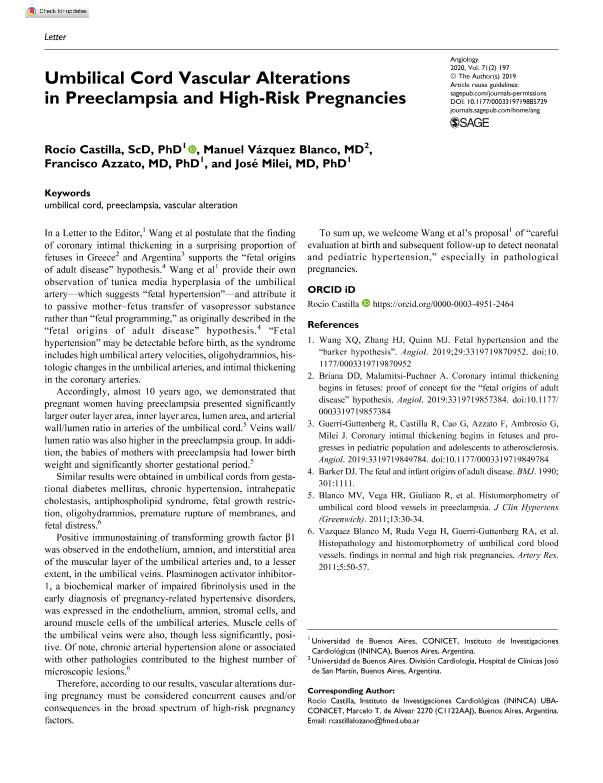Artículo
Umbilical Cord Vascular Alterations in Preeclampsia and High-Risk Pregnancies
Fecha de publicación:
01/2019
Editorial:
SAGE Publications
Revista:
Angiology
ISSN:
0003-3197
Idioma:
Inglés
Tipo de recurso:
Artículo publicado
Clasificación temática:
Resumen
In a Letter to the Editor,1 Wang et al. postulate that the finding of coronary intimal thickening in a surprising proportion of fetuses in Greece2 and Argentina3 supports the fetal origins of adult disease hypothesis.4 The authors1 provide their own observation of tunica media hyperplasia of the umbilical artery which suggests fetal hypertension and attribute it to passive mother-fetus transfer of vasopressor substance rather than ?fetal programming, as originally described in the fetal origins of adult disease hypothesis.4 Fetal hypertension may be detectable before birth, as the syndrome includes high umbilical artery velocities, oligohydramnios, histologic changes in the umbilical arteries, and intimal thickening in the coronary arteries. Accordingly, almost 10 years ago, we demonstrated that pregnant women suffering preeclampsia presented significantly larger outer layer area, inner layer area, lumen area, and arterial wall/lumen ratio in arteries of the umbilical cord.5 Veins wall/lumen ratio was also higher in the preeclampsia group. In addition, the babies of mothers with preeclampsia had lower birth weight and significantly shorter gestational period.5Similar results were obtained in umbilical cords from gestational diabetes mellitus, chronic hypertension, intrahepatic cholestasis, antiphospholipid syndrome, fetal growth restriction, oligohydramnios, premature rupture of membranes and fetal distress.6Positive immunostaining of transforming growth factor β1 (TGF-β1) was observed in the endothelium, amnion and interstitial area of the muscular layer of the umbilical arteries and, to a lesser extent, in the umbilical veins. Plasminogen activator inhibitor-1 (PAI-1),a biochemical marker of impaired fibrinolysis used in the early diagnosis of pregnancy-related hypertensive disorders, was expressed in the endothelium, amnion, stromal cells and around muscle cells of the umbilical arteries. Muscle cells of the umbilical veins were also, though less significantly, positive. Of note, chronic arterial hypertension alone or associated with other pathologies contributed to the highest number of microscopic lesions.6Therefore, according to our results, vascular alterations during pregnancy must be considered concurrent causes and/or consequences in the broad spectrum of high risk pregnancy factors.To sum up, we welcome Wang et al.s proposal1 of "careful evaluation at birth and subsequent follow-up to detect neonatal and pediatric hypertension", especially in pathological pregnancies.
Palabras clave:
PREECLAMPSIA
,
UMBILICAL CORD
,
VASCULAR ALTERATION
Archivos asociados
Licencia
Identificadores
Colecciones
Articulos (IATIMET)
Articulos de INSTITUTO ALBERTO C. TAQUINI DE INVESTIGACIONES EN MEDICINA TRASLACIONAL
Articulos de INSTITUTO ALBERTO C. TAQUINI DE INVESTIGACIONES EN MEDICINA TRASLACIONAL
Articulos(ININCA)
Articulos de INST.DE INVEST.CARDIOLOGICAS (I)
Articulos de INST.DE INVEST.CARDIOLOGICAS (I)
Citación
Castilla Lozano, Maria del Rocio; Vázquez Blanco, Manuel; Azzato, Francisco; Milei, Jose; Umbilical Cord Vascular Alterations in Preeclampsia and High-Risk Pregnancies; SAGE Publications; Angiology; 71; 2; 1-2019; 1-1
Compartir
Altmétricas




